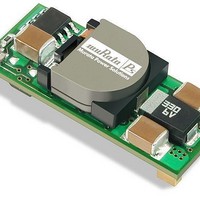LSM-1.8/10-D3-C Murata Power Solutions Inc, LSM-1.8/10-D3-C Datasheet - Page 6

LSM-1.8/10-D3-C
Manufacturer Part Number
LSM-1.8/10-D3-C
Description
DC/DC SM 10A 3-1.8V Non-Iso
Manufacturer
Murata Power Solutions Inc
Series
LSMr
Datasheet
1.LSM-0.810-D3-C.pdf
(13 pages)
Specifications of LSM-1.8/10-D3-C
Product
Non-Isolated / POL
Output Power
18 W
Input Voltage Range
3 V to 3.6 V
Number Of Outputs
1
Output Voltage (channel 1)
1.8 V
Output Current (channel 1)
10 A
Output Type
Low Voltage
Lead Free Status / Rohs Status
Lead free / RoHS Compliant
Note: Resistor values are in k . Accuracy of adjustment is subject to
tolerances of resistors and factory-adjusted, initial output accuracy.
LSM-1/10-D3
LSM-1.2/10-D3
LSM-1.5/10-D3
LSM-1.8/10-D3
LSM-2/10-D3
LSM-2.5/10-D3
V
Model
O
= desired output voltage. V
Figure 7. Trim Connections Using Fixed Resistors
Figure 6. Trim Connections Using a Trimpot
Note: LSM-0.8/10-D3 is not trimmable.
R
R
R
T
T
T
R
R
R
DOWN
DOWN
DOWN
Trim Equations
T
T
T
UP
UP
UP
(k ) =
(k ) =
(k ) =
(k ) =
(k ) =
(k ) =
O NOM
Trim Equations
= nominal output voltage.
V
1.62(V
2.49(V
www.murata-ps.com
2.37(V
V
V
1.296
V
O
1.992
O
O
1.896
– V
1.2 – V
O NOM
1 – V
– 1
– 1.2
O
O NOM
O
O
– 0.8)
– 0.8)
– 0.8)
– V
O
– 1
O
Note:
Install either a fixed
trim-up resistor
or a fixed trim-down
resistor depending upon
desired output voltage.
– 2.37
O
– 4.99
– 1
– 2.37
– 4.99
Output Reverse Conduction
Many DC/DC's using synchronous rectification suffer from Output Reverse
Conduction. If those devices have a voltage applied across their output before
a voltage is applied to their input (this typically occurs when another power
supply starts before them in a power-sequenced application), they will either
fail to start or self destruct. In both cases, the cause is the "freewheeling" or
"catch" FET biasing itself on and effectively becoming a short circuit.
LSM D3 SMT DC/DC converters do not suffer from Output Reverse Conduc-
tion. They employ proprietary gate drive circuitry that makes them immune
to applied output voltages.
Thermal Considerations and Thermal Protection
The typical output-current thermal-derating curves shown below enable
designers to determine how much current they can reliably derive from each
model of the LSM D3 SMT's under known ambient-temperature and air-flow
conditions. Similarly, the curves indicate how much air flow is required to
reliably deliver a specific output current at known temperatures.
The highest temperatures in LSM D3 SMT's occur at their output inductor,
whose heat is generated primarily by I
developed using thermocouples to monitor the inductor temperature and
varying the load to keep that temperature below +110°C under the assorted
conditions of air flow and air temperature. Once the temperature exceeds
+115°C (approx.), the thermal protection will disable the converter. Automatic
restart occurs after the temperature has dropped below +110°C.
As you may deduce from the derating curves and observe in the efficiency
curves on the following pages, LSM D3 SMT's are more efficient at lower
current levels. Also I
lower current levels. Consequently, LSN-D3 SMT's deliver very impressive
temperature performance if operating at less than full load.
Lastly, when LSM D3 SMT's are installed in system boards, they are obvi-
ously subject to numerous factors and tolerances not taken into account here.
If you are attempting to extract the most current out of these units under
demanding temperature conditions, we advise you to monitor the output-
inductor temperature to ensure it remains below +110°C at all times.
Single Output, Non-Isolated, 3.3V
Technical enquiries email: sales@murata-ps.com, tel:
2
R losses in the output inductor are significantly less at
LSM-10A D3 Models
10 Amp DC/DC’s in SMT Packages
2
R losses. The derating curves were
MDC_LSM-10A D3.B01 Page 6 of 13
IN
, 0.8-2.5V
+1 508 339 3000
OUT





















